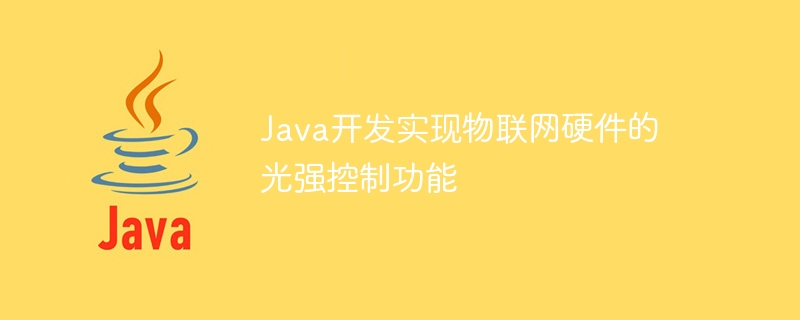

Java development to implement the light intensity control function of IoT hardware
Abstract:
This article introduces how to use Java language to develop the light intensity control function of IoT devices . First, we will briefly introduce the background and significance of IoT and light intensity control. Then, we will introduce how to use the Java language to develop the basic framework of IoT hardware devices. Finally, a specific code example will be given to implement the light intensity control function of IoT hardware.
1. Introduction
The Internet of Things (Internet of Things) refers to connecting the physical world to the network through various embedded sensors, devices and software systems to realize interaction and data between things. Communication technology system. Light intensity control is a common requirement in IoT applications, which can achieve automation or remote control by controlling the brightness of the light source.
2. Basic Framework
In the Java language, we can use various libraries and frameworks to develop the light intensity control function of IoT hardware. Here is a simple basic framework example:
3. Code Example
The following is a simple code example that obtains light intensity data by connecting to an Arduino hardware device and controls the light intensity according to the threshold:
import com.fazecast.jSerialComm.SerialPort;
public class LightIntensityControl {
public static void main(String[] args) {
SerialPort comPort = SerialPort.getCommPort("/dev/ttyACM0");
comPort.setComPortParameters(9600, 8, 1, SerialPort.NO_PARITY);
comPort.openPort();
while (true) {
byte[] readBuffer = new byte[comPort.bytesAvailable()];
int numRead = comPort.readBytes(readBuffer, readBuffer.length);
String intensity = new String(readBuffer);
int lightIntensity = Integer.parseInt(intensity.trim());
if (lightIntensity > 500) {
// 控制光源关闭
System.out.println("Turn off the light source");
} else {
// 控制光源开启
System.out.println("Turn on the light source");
}
try {
Thread.sleep(1000);
} catch (InterruptedException e) {
e.printStackTrace();
}
}
comPort.closePort();
}
}IV. Summary
This article briefly introduces how to use Java language to develop the light intensity control function of Internet of Things devices. First, we introduce the background and significance of IoT and light intensity control. Then, we provide the basic framework for the development of light intensity control functions for the Internet of Things. Finally, a specific code example shows how to use Java language to implement the light intensity control function of IoT hardware. I hope this article can help readers better understand and apply IoT technology.
The above is the detailed content of Java development and implementation of light intensity control function for IoT hardware. For more information, please follow other related articles on the PHP Chinese website!
 What are the applications of the Internet of Things?
What are the applications of the Internet of Things?
 The m2m concept in the Internet of Things
The m2m concept in the Internet of Things
 How to use digital currency
How to use digital currency
 The difference between arrow functions and ordinary functions
The difference between arrow functions and ordinary functions
 How is the performance of php8?
How is the performance of php8?
 How to create a soft link
How to create a soft link
 cad2012 serial number and key collection
cad2012 serial number and key collection
 How to draw pert diagram
How to draw pert diagram




